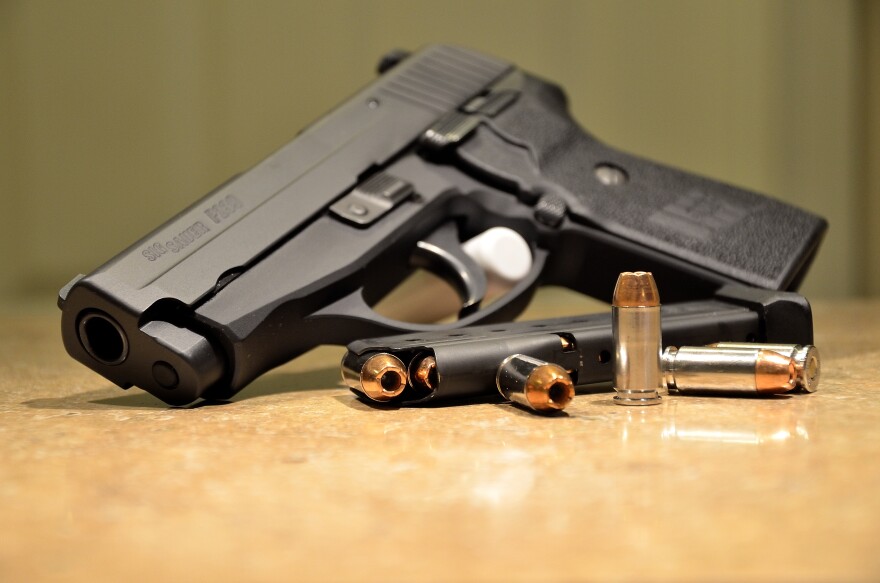Gunshots are ringing through Louisville's streets at a heightened rate this year.
Louisville Metro police reported nearly 200 shootings through the end of May. That's a nearly 40 percent increase compared with last year, which ended with the highest homicide count here in nearly four decades.
The spike is leading some Metro Council members to push for new technology that captures the sound of gunfire and records instances when shots ring out, then notifies police. They claim the technology would help reduce gun violence.
The council's public safety committee on Tuesday called a special meeting to discuss the potential for using city funds to pay for a gunshot tracking system known as ShotSpotter. The system uses an array of microphones and sensors installed atop buildings and utility poles to listen for the distinctive pop of gunshots. Police are alerted after a gunshot is recorded.
About 90 cities across the country have contracts with ShotSpotter, including Glendale, Arizona, the former post of Louisville Metro Police Chief Steve Conrad. Through a spokesperson, he declined to comment on whether the department wants to see the technology implemented in Louisville. Conrad told The Courier Journal earlier this month the gunshot tracking system looks "very promising to address some of the problems that we're seeing."
But some council members aren't convinced.
Councilman Bill Hollander, a Democrat from District 9, cited an April report from the investigative news outlet Reveal highlighting the lack of tangible results from ShotSpotter. The report noted that the system in San Francisco alerted police to more than 3,000 gunshots during a two-year period, but it resulted in just two arrests — only one of which was gun-related.
"I think we should take a serious look at not only who is using it, but who has decided not to use it," Hollander said.
A handful of cities, including Charlotte — considered a "peer city" of Louisville by Metro officials — opted to cancel their subscriptions to the service, according to the report from Reveal. In Charlotte, police officials said the technology generated calls related to gunfire, but it failed to produce needed arrests.
"We were having a hard time being able to show that data that we had actually arrested individuals who were responsible for the gunfire in which the calls were generated for," Major Steve Willis of the Charlotte Police Department told Reveal.
Charlotte officials decided to instead use the money for more surveillance cameras on the streets.
Ralph Clark, president of ShotSpotter, said the goal of the monitoring system is not to produce arrests but to make police aware of the gunshots that don't get reported. He estimates that roughly 20 percent of all gunshots are reported to local police departments across the country.
Responding to more shootings could help police build stronger rapport with communities struggling with gun violence, Clark said.
"The quicker you can get to a scene, recover physical evidence, interview people, show people you care ... that brings down the anti-snitching barrier that exists in a lot of communities and, all of a sudden, you get some very interesting intel," he said.
Councilwoman Jessica Green, a Democrat from District 1, said the "no-snitch" culture is keeping residents from reporting shootings. And, she said, once police are called and arrive at a scene, it's often too late to find any credible evidence.
"We want to take a little bit of the burden off the average citizen and put it on the technology," she said.
Clark admitted it's tough to provide tangible evidence of the impact the gunshot monitoring system can have on gun violence. "But we do produce real data," he said.
The full scope of that data, however, isn't likely to be made available to the public.
Clark said the private company "recommends" police departments share only summaries of shooting data. Detailed information, like specific shooting locations and how many shots were fired in a single incident, are kept secret, he said.
"You can only reduce gun violence if you're transparent with the data, right, to some degree," he said.
The idea is to get about 120 cities signed up for the service, then sell the data to federal agencies like the Federal Bureau of Investigation, Clark said.
Costs Involved
Clark said the technology costs cities about $65,000 a year for each square mile covered. The minimum coverage area is three square miles.
Green said she supports funding the system at the minimum — as a trial, of sorts.
"Let's at least give it a try," she said. "Let's see if it works. If it doesn't, let's nix it."
Councilman Kevin Kramer, a Republican who represents District 11, said he fully expects the system to be funded "if the police feel like it could help them do their jobs better." The council is expected to vote on a final budget Thursday.
Eddie Woods, an anti-violence activist and youth mentor in West Louisville, said simply responding to the sheer volume of gunshots would increase the workload for police officers on the streets. He said city funds could be better spent to help combat violence in other ways.
"They'd be better served to have bodies in the streets as opposed to systems," he said.
Woods wants more police on the streets. He said more officers walking through neighborhoods could help defuse situations that end in gun violence. And, if nothing else, he said more officers on the street mean more ears to hear gunshots ring out.






